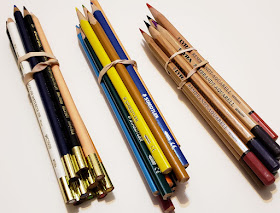 |
| The Persimmon Test: from left, Prismacolor, Staedtler, Lyra |
A few days ago I wrote a product review of the Caran d’Ache Prismalo
100th anniversary pencil set that ended with an insight about learning to use watercolor pencils in general. To
briefly summarize, I recalled using some low-quality water-soluble colored
pencils years ago and how they had “taught” me unproductive methods of using them.
Because I didn’t know any better, I continued to apply those methods when I
used higher-quality pencils later, not realizing how much more the better
pencils can do and with better results.
That insight prompted me to challenge myself to go back to
those low-quality pencils to see if the experience I’ve gained in the past
couple of years would affect how I use them and the results. (I got this idea partly
from Liz Steel’s interesting post about student-grade and artist-grade watercolor paints.) Unfortunately, it turned
out that I no longer had the poor-quality pencils that had given me so much
frustration back then (I think I got rid of them a year ago during a studio cleaning frenzy).
That said, I still own several brands of water-soluble colored pencils
that may not necessarily be low quality or student grade, but for various
reasons, I decided years ago not to use them anymore. I may have pushed them
aside because I didn’t know how to use them properly, and therefore they didn’t
perform as I expected them to. Or they may simply be of poor quality and will
never perform well (and, if you recall the moral to my story in the insightful post, the problem with using low-quality
products when you’re inexperienced is that you don’t know the difference
between those two alternatives). Probably I also started acquiring the pencils that
came to be my favorites (Caran d’Ache Museum Aquarelle, Faber-Castell Albrecht Durer and Caran d’Ache Supracolor) around that time, so I easily left the others behind.
On Thanksgiving, we were given a bag of persimmons – a fruit we don’t
usually buy – so with fresh subject matter, I tested three brands of long-unused
watercolor pencils: Prismacolor (USA-made by Sanford, so technically these may
be “vintage;” the watercolor pencils currently marketed under the Prismacolor name are made in Mexico and
look entirely different from the ones I own); Staedtler triangular; and Lyra Rembrandt Aquarell. All three inexpensive sets were small, and one wasn’t
even complete, so I had the additional (ultimately fun) challenge of using limited
palettes.
Prismacolor
My old Prismacolor watercolor pencils turned out to be a pleasant
surprise. Harder than traditional, wax-based Prismacolor pencils (which are
known for their buttery softness), the watercolor pencils retain their points
reasonably well. Although they don’t contain as much pigment as my favorites,
they activate and blend easily. Based on their performance, the pigments might
be considered artist grade.
I’m guessing that I rejected them because they are harder than
most watercolor pencils, and back then I didn’t know how to appreciate hard pencils for their particular uses.
My incomplete set is missing some basics (like red), so I had an
interesting time mixing persimmon hues with the colors I had. I wouldn’t mind
completing the set, but I don’t dare touch contemporary Prismacolors (which
have a bad habit of breaking easily). If I want more, I probably have to go to
eBay.
Staedtler Triangular
Blick lists Staedtler Triangular watercolor pencils in the “Kids
and Classroom” category (one step below student grade), and based on their
ergonomic shape and price, I’d agree with that placement. Even harder than Prismacolors,
they retain their points beautifully (when they aren’t breaking; both the wood
and the cores may have quality issues). I enjoyed drawing the challenging persimmon
leaves and their shadows because the Staedtlers are excellent for details.
Lyra Rembrandt Aquarell
Listed as artist grade by Blick, Lyra Rembrandt Aquarells are
soft, waxy and somewhat crumbly. Of the three pencils in my persimmon test,
these were the least pleasant to use. Although I tend to generally prefer
softer pencils, these took a long time to build sufficiently intense hues. I
experienced some of the “skidding” effect that I wrote about in the previous
post: Dry pencils applied to areas that had been previously activated felt like
they were skidding over a waxy surface. For artist-grade pencils, they seem to
lack pigment and are difficult to activate. I prefer the kids’ Staedtlers to
these.
What did I learn from this idiosyncratic, somewhat masochistic
exercise?
- Since all three are within the same inexpensive price range, I was surprised that the kids’ Staedtlers were more enjoyable to use than the artist-grade Lyras. This may indicate nothing more than my subjective experience with varying pencil qualities such as waxiness.
- Both the Staedtlers and the Lyras took more work – more repeated layers of dry-wet/dry-wet – to achieve what I considered to be sufficiently intense hues. (Using any of my favorites is much easier in that way because the pencils contain more pigment.) If I were a beginner who didn’t understand how to do this type of layering (or couldn’t, due to the limitations of the product), I would have been frustrated.
- I’m not unhappy with any of the persimmon sketches; I like different qualities of each. Although I struggled and had to work harder in some cases, I hope that’s not apparent in the results. This says to me that it’s possible to get satisfactory results from less-than-ideal materials (or simply materials I don’t like) if I have enough experience to compensate for any shortcomings of a product.
- I’m going to limit my palette more frequently, even when I don’t have to. It’s fun and challenging to mix with an odd selection of hues.
 |
| 9/21/11 One of my earliest attempts to sketch with water-soluble colored pencils. |



No comments:
Post a Comment